Fall IDF 2005 - Day 1: Intel Introduces new Microprocessor Architecture
by Anand Lal Shimpi on August 23, 2005 12:08 PM EST- Posted in
- Trade Shows
Intel's New Micro-Architecture
Of course, the big story of the day is Intel's new focus for microprocessor architectures.
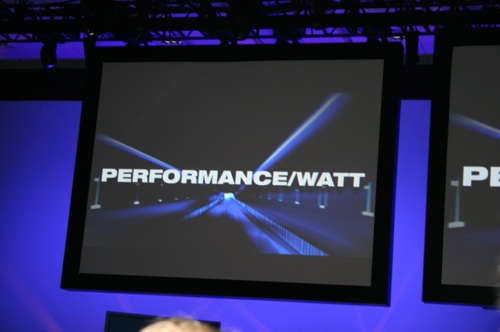
Intel's next microprocessor architecture will finally unify their desktop and mobile architectures, for a new focus on performance per watt as the driving force behind future CPU development.
Intel formally announced their first CPUs based on their next-generation microarchitecture: Woodcrest, Conroe and Merom. All of these CPUs will be built on a 65nm process and will be 64-bit enabled.
The new processors will be available in the 2H of 2006 and will significantly improve performance per watt over the current generation processors:
Woodcrest and Merom will both improve performance per watt by a factor of 3 over their predecessors.
Thanks to the death of NetBurst, Conroe will feature a 5x increase in performance per watt. Here's to the death of the power-hungry Intel processor.
Intel also set power consumption targets for the next-generation of systems based on these new 65nm processors:
On electrical cost savings alone, PC users will save $1 billion per year for every 100M computers.
The reduction in power will enable a new class of devices to be created at the 0.5W marker - the Handtop. The Handtop is basically a very small PC, that may end up being what everyone envisioned the Tablet PC as being.
Intel then went on to show off actual running silicon for all of their new CPUs, Conroe, Merom and Woodcrest.
Merom, a dual core mobile CPU, was running 64-bit Windows XP.
Intel had Conroe running a copy of Fedora Linux. Conroe is also a dual core product:
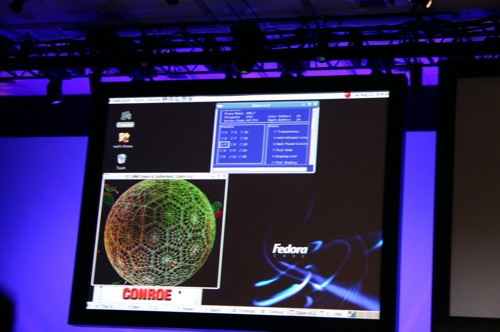
Intel's Woodcrest was running Windows Server 2003 in a DP configuration, with each processor featuring two cores:
We hope to have more information on Intel's new architecture as the week goes on, so stay tuned.


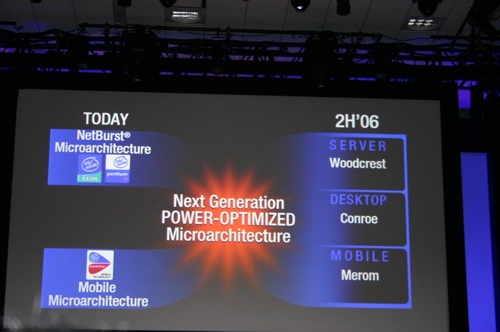
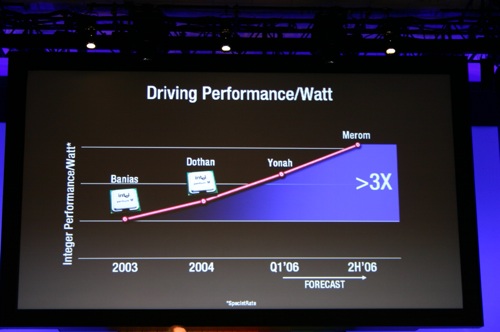
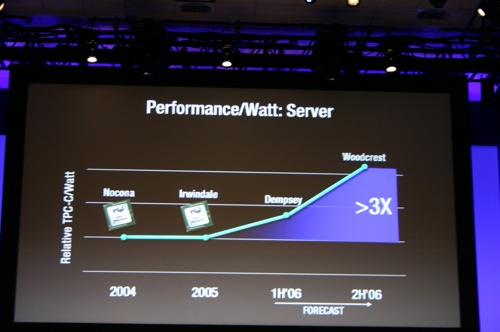


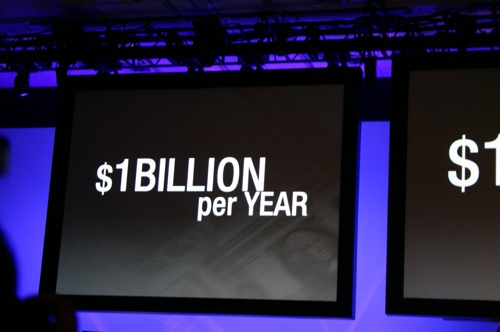
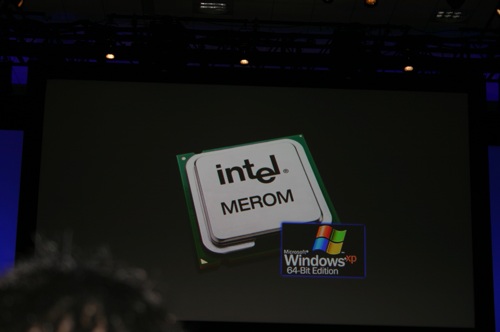
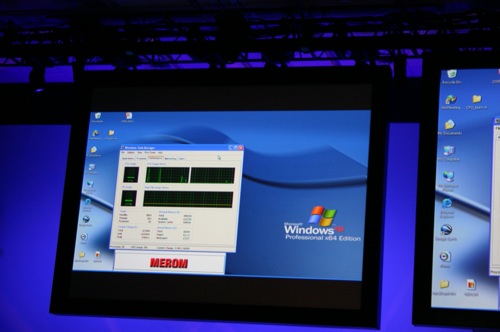
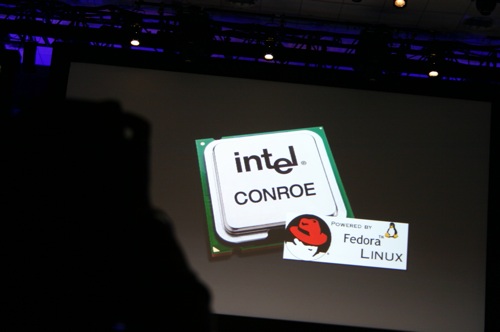










34 Comments
View All Comments
Griswold - Wednesday, August 24, 2005 - link
The IDF has been renamed to IMF - Intel Marketing Forum.creathir - Tuesday, August 23, 2005 - link
Why on earth are their chipsets/CPUs named after Texas small towns? Our corpoate office is in Bulverde, TX and we have a store in Conroe, TX. Whats next? The Huntsville? Austin? Oh I know. The Midland.- Creathir
IntelUser2000 - Thursday, August 25, 2005 - link
Creathir, you know its a code-name that otherwise won't be revealed anywhere but over computer forums, so it doesn't matter.And I can sort of see that 5x performance/watt increase as valid. Since they are comparing against Northwood for 5x figure, and against Smithfield is like 4-4.5.
Let's look at Pentium M. It already performs more than 30% faster per clock than Pentium 4. Conroe was said to be many that it will be 30% faster than Yonah, and Yonah is advancement per clock over Dothan, current Pentium M.
Since its 65W, against Pentium D's 130W, there is advantage of two already. The 2-2.25 reduces to 50-70% advantage after factoring out Conroe vs. Yonah. Get what I mean??
achbed - Tuesday, August 23, 2005 - link
...Apple is moving to Intel. I'll be the low-power, high-performance requirements for the Powerbooks is a *HUGE* factor - and this 64-bit laptop version is why Apple is interested. IBM just couldn't deliver on the power/performance ratio on the laptop side...bupkus - Tuesday, August 23, 2005 - link
10X performance/watt = 10GHz processorsATI move over, Intel has the vaporware podium now.
I was going to buy a dual core A64, but I'm going to wait now.
bldckstark - Tuesday, August 23, 2005 - link
Power per Watt as we all know is a measurement pertaining to notebooks. Their slides show that desktop purchases will reach zero by the end of the decade (look at the graph and extrapolate 55% to 47% in 1 year) so they are betting on the notebook avenue for future revenue increases. From what I am seeing in this article they are betting VERY heavily on portability. They attribute the Centrino package with quadrupling access points, which in turn increased notebook purchases. I personally think they are nuts. They are giving up on the desktop, basically cedeing this ground to AMD, and moving into a market where they have an advantage.AdvanS13 - Tuesday, August 23, 2005 - link
actually if you watched the presentation, which you can't (live webcast here in the offices).this is the mobility group, as there focus is on mobility, each group has their own mission/goals, so of course their slides are geared towards that focus.
looking at pictures, with no words is a big difference. if you've watched or been at idf today, you will see how the focus is to make each group (desktop/server/mobile) on basically one architecture, sans itanic.
0 at the end of the decade, i didn't know the graph went that far. there are plenty of desktop products coming, don't make assumptions so soon.
xsilver - Tuesday, August 23, 2005 - link
OMGcan u even read a graph
yes desktop purchases are going to reach zero by the end of the decade
and by the end of the next decade they will reach -50%
/end sarcasm
its called a plateau -- and the reason why intel is shifting is that there is more money to be made on mobile products
Calin - Wednesday, August 24, 2005 - link
rotf at the -50% at the end of the next decade...Until the laptops would be just as powerful, just as cheap, just as fast (hard drive speed wise), have dual DVI, accept professional video cards, and even more, be just as big and heavy as desktops to avoid "shoplifting" them from schools, libraries and so on,
there WILL be a market for desktop computers.
bupkus - Tuesday, August 23, 2005 - link
In fact, I do like the Mac Mini and the SFF designs and I would welcome a full powered SFF. I won't get a laptop as I still have a place for a desktop with it's larger ergonomic keyboard and dual LCDs. What can I say? I like the promises, but will I be left at the alter?